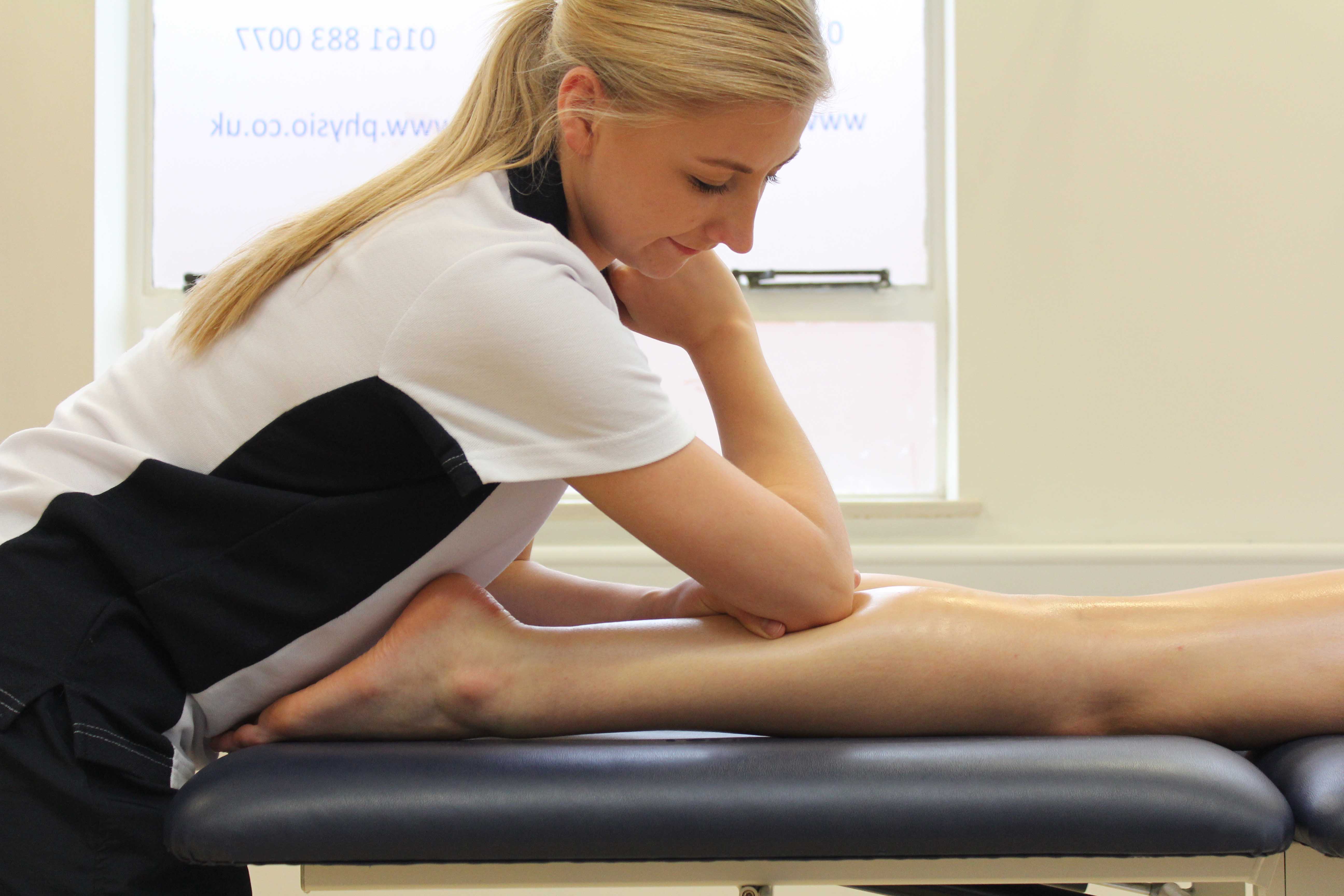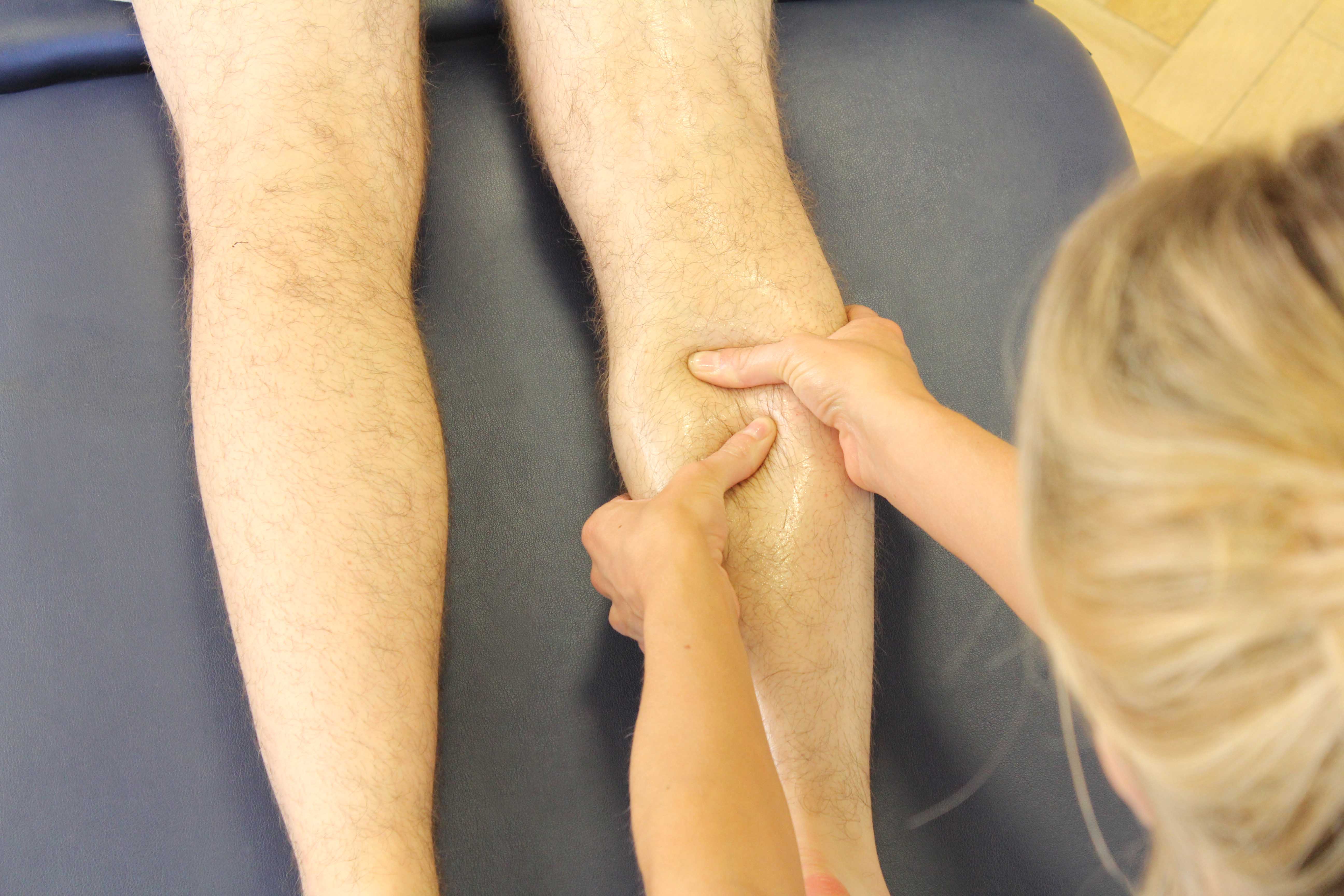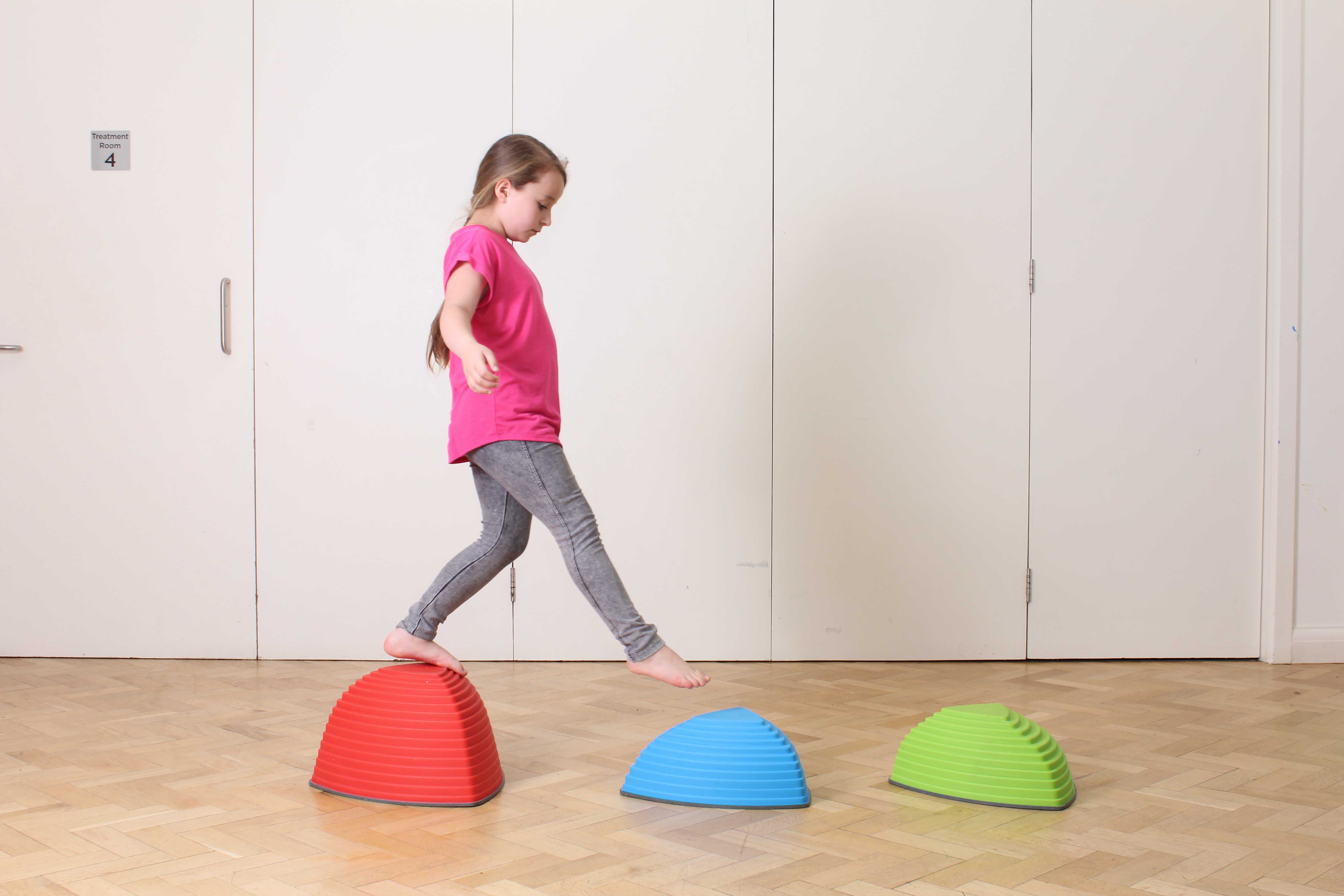External Fixation of Lower Leg
External fixationof the lower leg is a surgical procedure to externally immobilise and fix a bone following a fracture allowing the bone to heal effectively. Physiotherapy after external fixation surgery is essential to mobilise and return function in the lower leg.
The bones in the lower leg include the tibia (shin bone) and the fibula (smaller long bone). A fracture of the lower leg can affect the shaft of one or both of the bones in the lower leg. Fractures of the tibia / fibula are mainly caused by either a direct blow to the lower leg or by a twisting force when the foot is fixed. There are many different types and severity of fractures. The various severities of fractures to the lower leg include:
- Non-displaced (bones are still in position)
- Displaced (out of position)
- Closed fractures (where the skin is not broken by the fracture fragments)
- Open fractures (where the fracture fragments have broken through the skin)
 Above: Rolling soft tissue massage of the gastrocnemius muscle
Above: Rolling soft tissue massage of the gastrocnemius muscleThe skin and tissues that cover the front of the tibia and fibula are very thin and as a result of this, a significant number of fractures to the lower leg are displaced, open fractures.
The main symptoms that follow a fracture to the lower leg include severe pain and reduced mobility as the leg will be extremely painful and difficult to move. With fractures of the lower leg there will be deformity at the site of the fracture, especially with open fractures. As a result of the large amount of tissue damage and loss of blood at the fracture site, there will also be a considerable amount of swelling and discolouration.
Treatment of lower leg fractures can vary depending on the severity of the fracture. If the bone is still in its correct alignment (non-displaced) then immobilisation with use of a splint or cast followed by physiotherapy is recommended. If the fracture is out of position (displaced) but the skin is still intact (closed fracture) then ORIF of the lower leg (open reduction internal fixation) is required.
In severe cases, external fixation surgery is necessary. External fixation surgery is a method of holding together the fragments of a fractured bone by using transfixing metal pins through the fragments and a compression device attached to the pins outside the skin surface. The main indications for the use of external fixation surgery are in cases where there has been a displaced, open fracture (the bone is out of position and has broken through the skin). Also external fixation is indicated when there is high risk of infection, considerable bone loss at the fracture site, and when other methods such as ORIF of the lower leg are inappropriate. Common types of external fixation used in the treatment of a lower leg fracture include X-Fix and Llizarov.
External fixation is a procedure that sets and immobilises the fractured bone in its correct alignment so as to enable and facilitate adequate healing of the lower leg. The method provides rigid fixation of the bones outside the body (external) in cases where other forms of immobilizationare inappropriate. External fixation is performed in an operating room, normally under general anaesthesia. During external fixation small holes are drilled into uninjured areas of bones around the fracture and special bolts or wires are screwed into the holes. Outside the body, a rod or a curved piece of metal with special ball-and-socket joints joins the bolts to make a rigid support. The fracture can be set in the proper anatomical configuration by adjusting the ball-and-socket joints. After the rods are fixed, regular cleaning where the pins have been insertedmust be performed to prevent infection at the site of surgery.In most cases it may be necessary for the external fixator to be in place for many weeks or even months. Most fractures of the lower leg heal from between 6 and 12 weeks. After this time the external fixators are removed using specialised wrenches and can be removed without any anaesthesia.
Once the external fixator has been removed, it is imperative to undergo a comprehensive and prolonged course of physiotherapy to maximise the success of the procedure and to help ensure the return of full or near to full function in the lower leg post fracture.
 Above: Deep tissue massage of the gastrocnemius muscle
Above: Deep tissue massage of the gastrocnemius muscleSymptoms after External Fixation of the Lower Leg
During the months you have external fixators inserted into your lower leg you will be given elbow crutches to provide protection, support and independence. You will experience pain in the area of insertion along with abnormal sensations. You will be given medication to control for pain, reduce swelling and prevent infection. The ‘pin sites’ can be a source of infection therefore you will be shown by hospital staff how to carry out effective wound care and you may have to return to the hospital for regular check ups during s period.
After you have had the external fixators removed, you will experience pain, swelling and stiffness in and around the fracture site. You will have decreased range of movement, strength and muscle control in your lower leg as a result of the surgery and prolonged immobilisation. You will be non-weight bearing initially with progression to full weight bearing being encouraged as soon as possible. A comprehensive physiotherapy programme with Physio.co.uk should be initiated as soon as possible after the external fixators have been removed to regain mobility as well as full or near to full function in your lower leg. You will not be able to drive until you have full and painless function in your affected leg.
 Above: Trigger point massage of the gastrocnemius muscle
Above: Trigger point massage of the gastrocnemius musclePhysiotherapy after External Fixation of the Lower Leg
Physiotherapy can begin immediately after you have had external fixation of your lower leg to help reduce pain, swelling and stiffness. It is encouraged to begin physiotherapy as soon as possible as this will help you regain mobility and improve range of movement and strength in your affected leg. Physio.co.uk offers a comprehensive physiotherapy course that will maximise the success of the surgery, prevent any problems occurring and ensure the return of full or near to full function in your lower leg. Rehabilitation can take up to 6 months after you have had ORIF surgery to your lower leg. The main goals of your rehabilitation with Physio.co.uk include:
- To restore a pain free lower leg
- To restore full range of motion (ROM)
- To restore full muscle strength
- To restore full muscle length and flexibility
- To improve cardiovascular fitness and muscle endurance
- To re-establish independence
 Above: Deep tissue massage of the gastrocnemius muscle
Above: Deep tissue massage of the gastrocnemius muscle0-4 weeks
The main goals of your physiotherapy programme in the first month after undergoing external fixation will be to reduce pain and swelling in your lower leg. Your physiotherapy programme with Physio.co.uk will aim to gradually introduce you back to gentle activity. Physio.co.uk will focus on maintaining the range of movement and strength in your affected and unaffected leg. Additionally, your physiotherapy will include activities that aim to progress your ability to weight bear as soon as possible. Your rehabilitation will include:
- Pain killers (to control pain)
- Elevation (to control swelling)
- Crutch training
- Non weight bearing activities progressed to partial weight bearing activities
- Passive (assisted) range of movement exercises for affected leg (knee, ankle etc)
- Strengthening and range of movement exercises for unaffected leg
- Upper limb activities
5-8 weeks
During the second month of your rehabilitation with Physio.co.uk your physiotherapy will focus on the continuation and progression of activities from previous weeks. Your physiotherapy programme with Physio.co.uk will continue to focus on controlling pain and swelling. Physio.co.uk will also continue to focus on improving range of movement nd flexibility along with increasing muscle strength and control. Your physiotherapy will include:
- Continuation of modalities for pain and swelling
- Passive (assisted) and active (independent) range of movement exercises
- Strengthening exercises for muscles of affected leg (calf, hamstring, quadriceps etc)
- Stretching exercises for muscles of affected leg (calf, hamstring, quadricep etc)
- Range of movement, strengthening and stretching exercises for unaffected leg
- Progression of weight bearing – full weight bearing activities if possible
- Gait re-education training
- Proprioception and balance training
- Hip and ankle exercises
- Hydrotherapy
- Static bicycle
9-12 weeks
After 2 months of physiotherapy, your rehabilitation your physiotherapy programme will continue to focus on the progression from previous weeks. The main goals of your physiotherapy programme with Physio.co.uk will aim to minimise pain, improve range of movement and increase strength. Once your ability to weight bear has improved, your physiotherapy programme will now focus on gait re-training (walking) and improving proprioception (balance) in your lower leg. At this stage, your physiotherapy will also begin to include activities that will improve your cardiovascular fitness and muscle endurance. Your physiotherapy will include:
- Pain control
- Gait training (walking)
- Proprioception training (balance)
- Range of movement exercises
- Flexibility exercises
- Strengthening exercises for muscles in affected and unaffected leg (calf, hamstring, quadriceps, tibialis anterior etc)
- Hydrotherapy
- Static bicycle
3-6 months
Following three months of successful rehabilitation with Physio.co.uk you will have seen marked improvements in the function of your lower leg and you will be experiencing minimal if no pain and swelling. After 12 weeks, the external pins will have been surgically removed and you will now be fully weight bearing. The main goals of your physiotherapy will continue to focus on the progression of exercises from previous weeks. Your physiotherapy will concentrate on activities that help improve the strength in the muscles of your lower leg by consistently building up resistance in the strengthening exercises. You should have full range of movement and your physiotherapy will aim to maintain and improve flexibility of both your lower limbs. Your rehabilitation will continue with proprioception and gait training. Cardiovascular activities such as hydrotherapy, cycling and gentle jogging can be included in your programme. Functional activities that focus on specific tasks related to your lifestyle, hobbies or job will also be included in your physiotherapy programme.
The success of your recovery after external fixation surgery will highly depend on you commitment to your physiotherapy programme as well as the condition of your leg prior to the surgery. Recovery will take up to 6 months.
Summary
External fixation of the lower leg is a surgical procedure that uses rods or plates to immobilise and fix a bone following a fracture to allow the bone to heal in its correct position. Fractures in the lower leg can occur along the shaft of the tibia (shin bone), along the shaft of the fibula (smaller long bone) or both. Treatment of a fracture to lower leg can vary depending on the severity of the injury. In severe cases where the bone is displaced and the fracture fragments have broken the skin (open fracture) external fixation is the most commonly utilised procedure. External fixation is required to enable correct alignment as well as facilitating adequate healing of the lower leg. External fixation allows the return of function as well as preventing future complications and deformation of the lower leg. Physiotherapy with Physio.co.uk after external fixation is crucial to ensure the success of the surgery, prevent the likelihood of any future problems and to help you achieve the return of full or near to full function within your lower leg. Commitment to a personal physiotherapy programme with Physio.co.uk will allow a more rapid return to everyday activities, work, hobbies, and sport. Call Physio.co.uk now on 0330 088 7800 for more information or to book an appointment please contact us.

 0330 088 7800
0330 088 7800


































